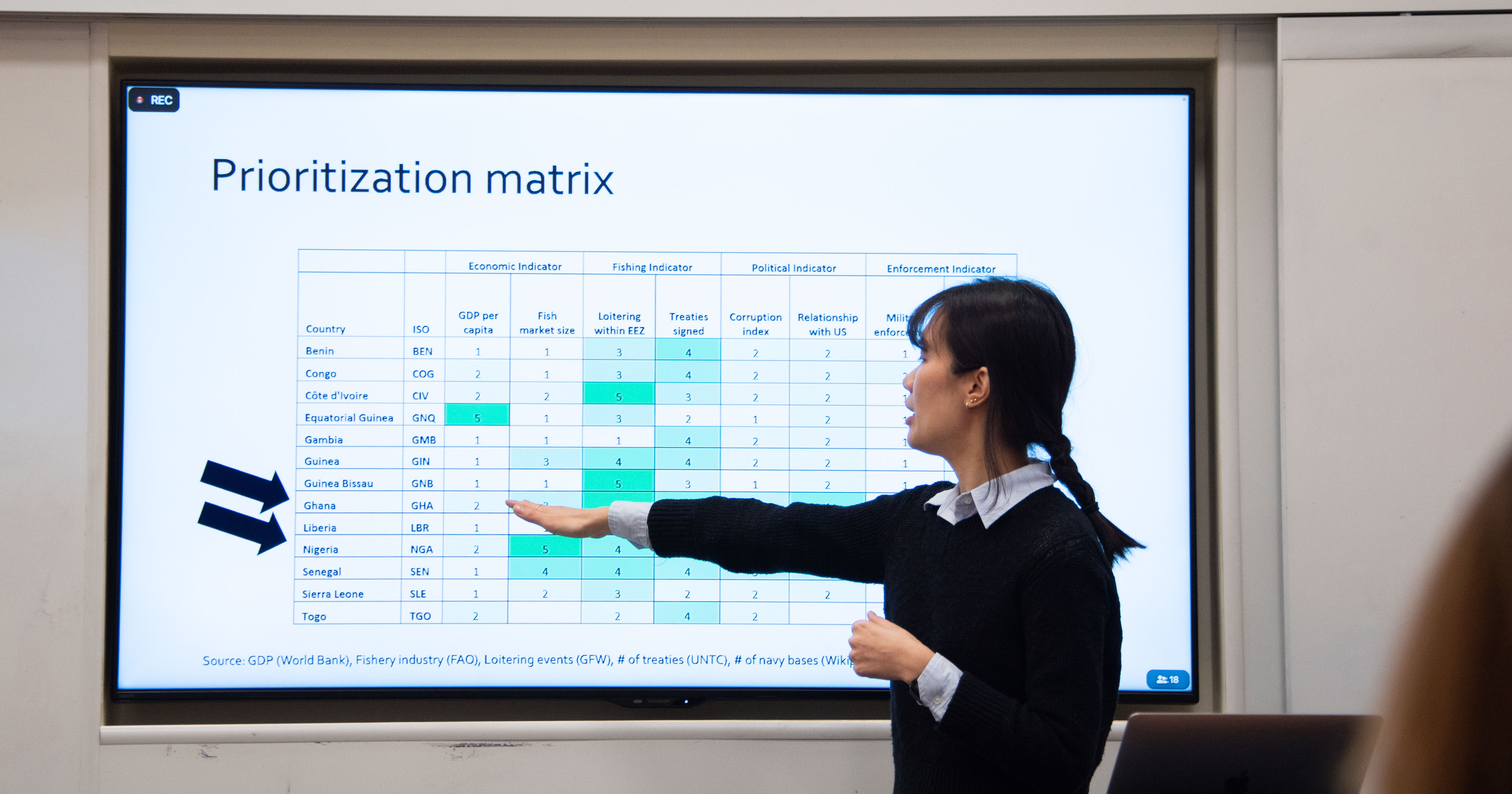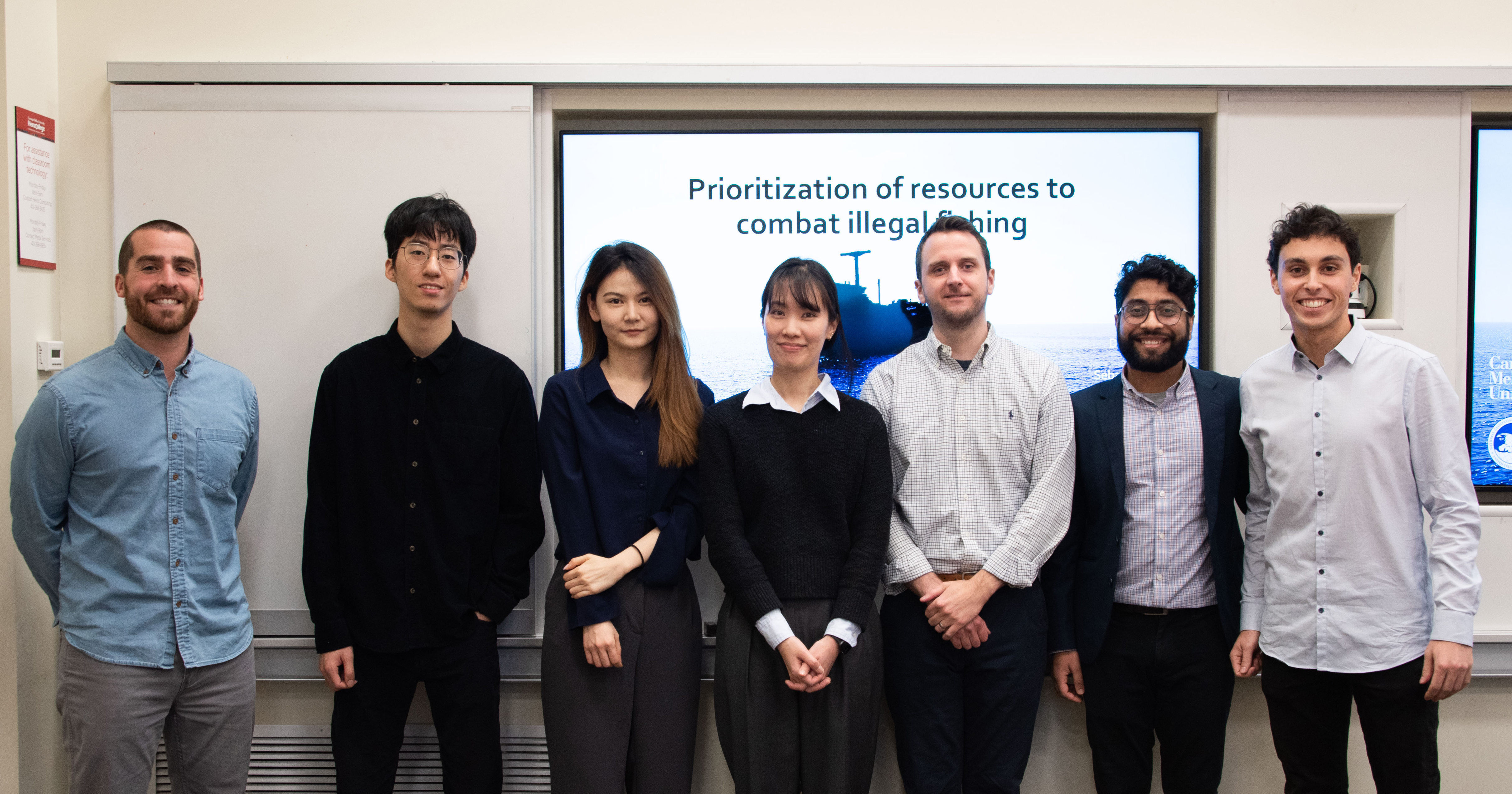Angling for a Solution to the World’s Illegal Fishing Problem
By Bill Brink
Heinz College has plenty of expertise in the prevention of cyber attacks, including phishing, the practice of sending fraudulent emails to obtain sensitive information.
Fishing, with an F? Not so much. Until now.
In 2022, a group of Heinz College students built a prototype of a data pipeline to help the National Geospatial-Intelligence Agency (NGA) combat illegal, unreported and unregulated (IUU) fishing. The students – Sebastian Dodt, Bikash Gupta, Yingzhe Jin, Eunyoung Lee, Ziyou Li, Liam McLane and Marc Weinheimer – built this pipeline for their Capstone project, during which students partner with real-world clients to help them solve a problem.
“We are told that it has had an impact, that it radically changed the way the National Geospatial-Intelligence Agency looks at illegal fishing,” Dodt said. “That’s something that’s super satisfying. My whole career, I’ve been striving to have an impact on the world. It’s the whole reason that I’m here.”
It started with a memo
The NGA’s portfolio includes a broad array of responsibilities. For most of its 26-year history, none of them involved fish.
The agency typically supplies intelligence to the military (it played a key role in the raid on Osama bin Laden’s compound), assists in the wake of natural disasters, and supports security efforts for large-scale events like the Olympics or the Super Bowl. But it also assists with counternarcotics, and after the White House released a memo in June of 2022 directing federal agencies to address the issue of IUU fishing, the NGA asked for a bit of help.

A problem of enforcement
There are 2.4 million powered fishing boats in the world, so the team focused on prioritization to help the NGA allocate its resources.
Policing IUU fishing is a tricky issue, and technology can help to a point. In 2015, Google partnered with the ocean conservation organization Oceana and the satellite technology firm SkyTruth to create Global Fishing Watch, an open-source, real-time suite of map and data analysis tools to track international fishing activity. But even if you can find the bad actors, reeling them in is another matter.
“One of the things that I encouraged everybody to think about is to not frame it entirely as cops and robbers, how do we catch people,” said Jonathan Caulkins, the H. Guyford Stever University Professor of Operations Research and Public Policy at Heinz College and the project’s advisor. “And that’s in part from my experience with analyzing other illegal markets. The problem with market-type crime is the tendency for easily replaceable assets to get replaced, even if they are incapacitated in some fashion. So you have to think about an economic model of the market and figure out what assets can be disabled that are harder to replace.”
Refining the search
Every fishing boat must be registered, or “flagged,” to a specific nation. Some nations, known as flag-of-convenience states, sell these registrations for profit and have little interest in policing IUU fishing. For other countries, their small navies and coast guards make it impossible to patrol their exclusive economic zone (EEZ), which extends 200 nautical miles from the edge of their territorial waters. An inconsistent patchwork of treaties and agreements governs – and sometimes fails to govern – enforcement in international waters.
“The problem is really complicated because you’re taking an illegal activity problem and then you’re dropping it thousands of miles in the middle of the ocean,” McLane said. “And on top of that, you’re giving every country in the world at least partial jurisdiction over a piece of this. And obviously, fish don’t respect national boundaries.”
Attempting to enforce IUU fishing by targeting the world’s estimated 2.4 million powered fishing vessels is lunacy, but there are bigger fish to fry.
The problem is really complicated because you’re taking an illegal activity problem and then you’re dropping it thousands of miles in the middle of the ocean. And on top of that, you’re giving every country in the world at least partial jurisdiction over a piece of this. And obviously, fish don’t respect national boundaries.Liam McLane, Capstone team member
“These fishing boats don't go back to ports every time that they fish,” Dodt said. “Instead, they meet ‘reefer’ vessels, these bigger support vessels, who give them fuel and take their fish and freeze it and package it. And then they go back out and steal fish again, and they can do that for years and never have to go to port.”
While the fishing boats frequently deactivate their automatic identification system (AIS) transponders, the support vessels must keep theirs on. That, combined with the fact that there are only 1,500 or so reefers at sea at a given time, makes them desirable targets. By mixing legitimate and illegal catch, the support vessels can launder the illicit fish on the world market.
One morning, a few hours before a meeting with his group, Dodt had an idea. He remembered reading about an incident in which a U.S. Coast Guard cutter attempted to intercept a fleet of Chinese fishing boats near the Galapagos Islands, scouring the waters off the coast of Ecuador in search of Humboldt squid. Some boats fled. One of them tried to ram the cutter.
“That’s right up their alley”
Among the boats that fled was the Yong Hang 3, a 472-foot-long reefer vessel considered one of the worst offenders in the IUU world. She’s flagged to Panama, but she’s essentially Chinese. These supply ships sometimes meet fishing boats with an active transponder in what is known as a tracked meeting. The meetings Dodt and his team were concerned about were “dark” meetings, when the reefer vessel remained stationary for hours, seemingly alone but almost certainly engaging in transshipment and resupply with a fishing boat. When those meetings take place in international waters just outside an EEZ, they’re a proxy for illegal activity.
Dodt ran a quick analysis to see which fishing boats had met with the Yong Hang 3, and which other reefer vessels they met. Networks and patterns emerged.
“The [NGA] advisor and two people on our team who have worked with the military before, they were like, ‘Wow, they will love this,’” Dodt said. “The military is all about networks. That's right up their alley. And I think that's one of the biggest things we contributed, was this network analysis.”

"We are told that it had an impact"
The team of Heinz College students wove their data dashboard into the larger geopolitical landscape to give the NGA actionable information.
Global Fishing Watch data has a 72-hour lag time, which makes real-time enforcement difficult. But SeaVision, a tool built for the Department of Transportation to track and sort thousands of ships around the world, contains information updated within the hour. Combining all this data, the team built the NGA a platform that at a glance shows a ship’s dark meetings, network, location, heading, and, most importantly in terms of enforcement, flag, EEZ status and proximity to U.S. waters.
Finding the ships is only half the battle. The group also synthesized data on treaties, corruption indexes, capabilities of navies and coast guards, EEZ size, and economy, as well as broader factors – Russia and China, for example, probably have little interest at the moment in assisting a U.S. federal agency – to help the NGA identify which boats the U.S. or an ally has a good chance of catching.
“I think it helped the NGA understand that they have intelligence capabilities, and this is a problem that could leverage intelligence capabilities, and they know where they fit into the whole puzzle,” McLane said. “Especially for these government agencies, if they have a new problem, just knowing where they fit into it can be a really good start.”
Fishing with an F: Now a part of the Heinz College tackle box.